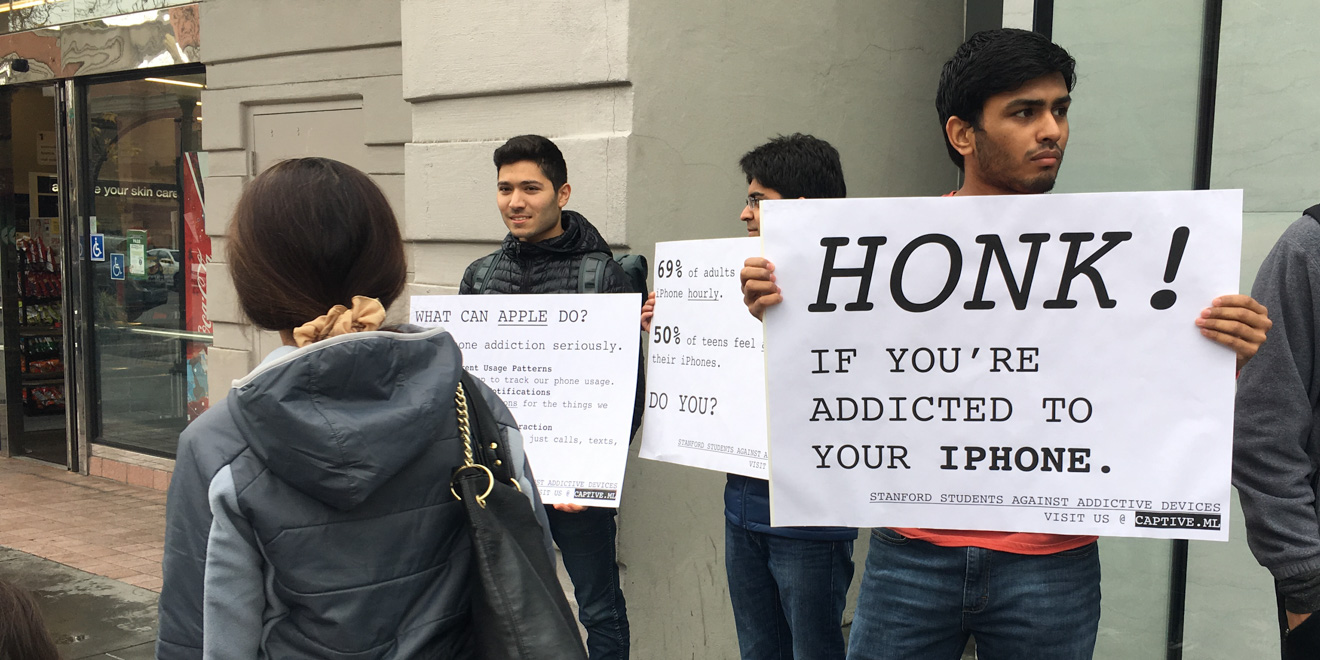Stanford Students Against Addictive Devices (SSAAD) staged a protest on Saturday outside of the Palo Alto Apple store on University Avenue. The student protesters claimed that Apple is failing to take steps to curb technology addiction. They also demanded that the company adjust software features to mitigate users’ constant focus on their devices.
“We felt that this is the kind of change that a lot of consumers have to demand before Apple takes sustained action,” said Sanjay Kannan ’18. “We did some research into how prevalent the problem was, and we realized that 50 percent of teens are addicted to their phones, and 69 percent of [parents] check their phone hourly.”
Kannan cited the statistics from a 2016 poll by Common Sense Media, which staged 1,240 interviews with children aged 12 to 18 and their parents. Kannan leads SSAAD alongside Evan Sabri Eyuboglu ’18, Cameron Ramos ’18 and Divyahans Gupta ’18, all of whom are Stanford computer science majors.
At the protest, SSAAD affiliates handed out fliers, which included a statement coauthored by members of SSAAD, enumerating their complaints and their demands for Apple. The statement cited three studies asserting that phone addiction increases stress, damages interpersonal relationships and reduces productivity, respectively.
In the statement, SSAAD asked Apple to introduce transparent usage patterns which would entail including “an app with every iPhone that tracks phone usage and clearly reports patterns.” Some usage tracking is already programmed into iPhones: currently, users can navigate to the “Battery” section of their settings and track the percentage of overall battery usage attributed to each of the phone’s applications over the past 24 hours and seven days.
On Jan. 9, in response to criticism over phone addiction, an Apple representative said, “We are constantly looking for ways to make our experiences better. We have new features and enhancements planned for the future, to add functionality and make these tools even more robust. We think deeply about how our products are used and the impact they have on users and the people around them. We take this responsibility very seriously and we are committed to meeting and exceeding our customers’ expectations, especially when it comes to protecting kids.”
Apple has made attempts to decrease the addictive power of its devices. For example, an iPhone user can set their phone to “grayscale mode,” which changes the iPhone display to shades of gray instead of color and aims to augment iPhone accessibility for color-blind users as well as mitigate phone addiction by reducing vibrant hues.
However, SSAAD called on Apple to do more. The protesters said that by granting more control over notifications to users, Apple can help mitigate device addiction. iPhone users can currently choose to enable or disable different types of notifications, such as banners and badges for individual apps.
Finally, SSAAD wants Apple to create a mode to reduce distraction. In their statement, SSAAD proposed an “Essential Mode,” where an iPhone would only be able to perform essential functions like phone calls, text messages, and photos.
Members of SSAAD said that Apple is well-suited to combat phone addiction due to a unique set of incentives. Unlike the creators of applications like Facebook or Snapchat, Apple does not make money based on how often a customer uses their iPhone.
Kannan said he hopes that if Apple, a leader in the smartphone industry, introduces measures to decrease phone addiction, other companies will follow suit.
“Historically, Apple has been the one [company] to popularize new features and make them something that every phone consumer expects,” Kannan said. “Face ID is a good example. Other companies did it before Apple, but once Apple did it, it’s like [it became] something we all need to have.”
Multiple passersby stopped to engage with the protesters on Saturday afternoon.
“I agree 100 percent,” one Palo Alto resident said, referring to the protesters’ claims and demands. “Young people today are completely addicted to their phones.”
Maria Bojorquez ’20, a Stanford student unaffiliated with the protest, also agreed with SSAAD’s observations and the organization’s desire to see phone manufacturing companies institute ethical reforms.
“I can totally see that a lot of my friends are addicted to their phones,” Bojorquez said. “When we hang out, they are constantly checking their notifications. I think if [someone] could see the number of times they check their notifications every day, they would see that they have a problem.”
The SSAAD founders believe that they and other computer science students have a moral obligation to speak out about technology addiction.
“We are going to go work for these different companies and we need to have some sort of ethical footing,” Kannan said. “I’d say this is one of the more uncontroversial issues out there. I think a lot of people agree that people are addicted to their phones.”
Holden Foreman contributed to this report.
Contact Sophie Regan at sregan20 ‘at’ stanford.edu.
This post has been updated to reflect that Divyahans Gupta, not Divya Gupta, is a leader of SSAAD. The post has also been updated to include more of Apple’s Jan. 9 statement and to cite the statistics Sanjay Kannan referenced.
An earlier version of the article also misspelled Kannan’s last name, as well as the group’s acronym, “SSAAD.” The Daily regrets these errors.
